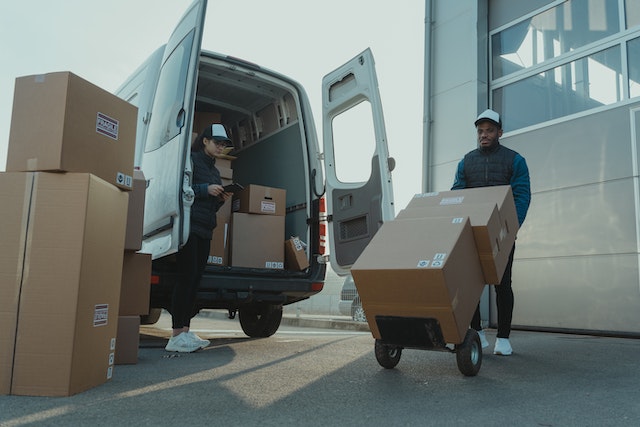Moving to a new home is an exciting adventure, but it often comes with a long checklist of tasks and important considerations. According to the U.S. Census Bureau, the average American moves 11.7 times in their lifetime. Based on the latest Annual Social and Economic Supplement (ASEC) data, 17.29% of those moves were state-to-state, meaning approximately 4.8 million Americans made interstate moves in 2021. Whether relocating across town or the country, the process can seem overwhelming. In this article, we’ll provide a roadmap to make your move as smooth and stress-free as possible, from planning and packing to settling into your new space to handling and setting up your utilities. We’ll share valuable expert advice and practical moving tips to help you navigate your relocation.
Moving tips
People move for all kinds of reasons, and each one marks an exciting new chapter. Maybe it’s a job opportunity that’s taking you to a new city, or you’re upgrading to a bigger home to fit your growing family. Sometimes it’s about finding a more affordable place, moving closer to loved ones, or settling into a place that’s family-friendly. Big life moments like getting married, retiring, or starting fresh after a change can also inspire a move.
Reputable moving companies will save you a lot of stress before, during, and after moving day. When you hire a professional moving company, part of their service is to guide customers in packing, moving, and setting up. For instance, moving companies can help you set up your utilities. They will help you with a checklist of utility providers in your new location, assist in scheduling the disconnect of old services, and coordinate installation dates for the new home.
However, it’s important to be aware of potential hidden costs that can come with hiring movers. Extra charges for things like long carry distances, stairs, last-minute rescheduling, or even packing materials can add up quickly if you’re not prepared. Always ask for a detailed quote upfront and clarify what is included to avoid unexpected costs. It’s all about making the transition as seamless as possible for you. Read on for more moving tips.
What arrangements should you make for the transfer or cancellation of utility services at your old address when moving to a new address?
Once you know your move-out date, contact your current utility providers (water, sewer, gas, electric, garbage, internet, etc). Tell them when you plan to move and provide them with your new address for communication purposes. Specify whether you want to transfer, if the option is available, or else disconnect your services. If applicable, arrange for the return of any rented utility equipment and cancel any subscriptions tied to your old address. A week or so prior to closing on your new home, reach out to the utility providers for your new address and let them know when you need utilities set up. Your realtor should be able to provide you with their contact information.
Remember to check with each provider for specific procedures, as these steps may vary depending on location. Be aware that some providers might not be able to arrange the setup of your new utilities until after you have closed on your new home. In that case, you’ll want to prioritize contacting them as soon as you close. If your local MLS provides a form for transfer of utilities, request that your real estate agent include that form in both your buying and selling transaction documents. This will ensure you don’t end up paying someone else’s bills after closing.
Ryan Palardy from Get Happy At Home
What steps should I take to set up new utility accounts when buying a home in a different location?
Setting up new utility accounts when purchasing a home in a different location can be a complex task, but with the right approach and tools like Econnex, it becomes more manageable.
- Research Local Providers: Start by identifying the utility companies serving your new area, including electricity, gas, water, internet, and more.
- Transfer or Disconnect Services: If you’re moving within the same service area, inquire about transferring existing services. If not, arrange for the disconnection of services at your old address.
- Create a Utility Checklist: List the utilities you’ll need and consider specific local regulations or requirements.
- Gather Necessary Documents: Ensure you have the essential documents like your lease, identification, and Social Security number.
- Budgeting: Understand the billing cycles and rates, and prepare for potential deposits or connection fees.
- Activate Services: Coordinate the activation of utilities to match your move-in date, with Econnex helping you find the best deals for your new location.
- Notify Previous Providers: Inform your previous utility providers about your move-out date to avoid post-departure charges. · Econnex Assistance: Use Econnex to compare and switch to the most suitable utility plans in your new location, helping you save money while simplifying the process.
By following these steps and leveraging Econnex’s services, you can efficiently set up new utility accounts when moving to a different location, ensuring that you start your new chapter with ease and savings.
Shweta Mittal from Econnex
What is the ideal timeline for selling my home and coordinating it with my move to a new location?
- Pre-Planning (6-12 Months Ahead): Begin by assessing your needs and goals. Do some area analysis — research your new location, think budget, and start decluttering and assessing any necessary repairs/refreshes — this is essential!
- Listing Your Home (3-6 Months Ahead): Once you’re ready to sell, list your home. Cute sells! Work with a real estate agent to market at the right price – the best price in the shortest time. Staging is often crucial (declutter again!);
- Sale and Closing (1-3 Months): The time your home takes to sell can vary, so be prepared for this phase to last anywhere from a few weeks to 60 days. With your agent, vet buyers vigorously to ensure the deal closes on time;
- Moving Plans (2-4 Months): Hire movers, schedule utility transfers, and notify schools or employers of your move. Starts packing and again, decluttering, donating, recycling, and otherwise purging items that you can part with;
- Moving Day (1-2 Days): Everything but essentials packed and ready to go! Final walkthrough of your old home, and say your goodbyes. Keep important documents and valuables with you during the move. Leave all manuals and helpful paperwork pertaining to the home for your new buyers (and a lovely letter to the new buyers is an extra special touch);
- Settling In (1-2 Weeks): Take a deep breath! Slowly and thoughtfully unpack — get out there and explore your new ‘hood!
Victoria Krause Schutte from @properties
How can I streamline the process of selling or renting my current residence when moving?
There are several things you can do to make the process of selling or renting your current home smoother when you are moving. First, get pre-approved for your mortgage if buying so you are ready to make an offer when you find the right home. Also, start decluttering and cleaning so your home shows well to potential buyers or renters. Hire a real estate agent to help market your home, schedule showings, review offers, and negotiate on your behalf.
Consider an open house to increase interest. Price competitively by researching comparable homes that have recently sold or rented in your area. Be flexible on showings, allowing potential buyers or renters to view the home on evenings and weekends if needed. Disclose any known defects upfront to avoid issues later. Use a service for renters like Cozy or Avail to streamline rental applications, background checks, and e-signing of leases to speed up the rental process. Moving is stressful enough, so take these steps to simplify selling or renting out your current place.
Ron Harmon from 1 Percent Lists
BE READY and START early. A lot of it can and should be done ahead of time, especially when you have solid plans.
What are the key questions for an international moving company?
- Licensing: Confirm the company’s licensing for international moves, ensuring they have the permits for cross-border transport and customs.
- Insurance Options: Inquire about insurance types, including Transit, All-Inclusive, and Third-party insurance, to cover damages during the move.
- Door-to-door Service: Check if they provide door-to-door service, as opposed to terminal-to-terminal.
- Move Duration: Ask about the expected time frame for the international move, noting it can range from days to weeks.
- Storage Facilities: Ensure they offer storage solutions for emergencies.
- Real-Time Tracking: Verify if they offer real-time tracking for your belongings.
- Move Management: Determine if the company handles the entire move or involves subcontractors and how they coordinate between them.
Abhishek Nath from Assureshift
How can I efficiently pack and organize my belongings for a smooth move?
When preparing for a move, efficient packing and organization can make the process smoother. Start by decluttering and getting rid of items you no longer need. This lightens the load and ensures you’re only moving what’s necessary.
Categorize your belongings to simplify packing. Group similar items together and pack them in clearly labeled boxes. This makes unpacking and locating items more accessible. Consider packing a “first-night” box with essentials like toiletries, a change of clothes, and important documents for immediate use.
Protect fragile items by wrapping them individually with bubble wrap or newspaper. For clothing, leave them on hangers and use garbage bags as makeshift garment bags to save time and effort.
Maximize space by packing strategically. Use suitcases for heavier belongings. Reinforce the bottoms of boxes with extra tape for added durability.
Lastly, create a detailed inventory of your items to keep track of during the move, and start packing and organizing your belongings on time. These steps will help improve the packing process and ensure a smooth move to your new home.
Nancy Zafrani from OZ Moving & Storage
Best moving tips
Start by decluttering and prioritizing items. Pack room by room, labeling boxes with contents and destination rooms. Utilize quality packing materials, and consider hiring professional movers for a seamless transition. Don’t forget to create an essentials box with daily necessities for immediate use upon arrival.
Kye Sampson from Nan and Company Properties
Can you give us an inside look at the high-end moving process?
Here are two key services to our proven approach to transform the moving experience into a luxury experience:
Tailored Service
We have premium partnerships with other luxury services to provide far more than just the relocation service. Our star-studded partnerships provide the finest pet care to pamper the pooch and feline during packing and moving; nanny services to keep kids safe, happy, and entertained; and professional organizers to keep things in their place on both ends of the move.
The Finest Packing Services
Not only will we pack and unpack belongings, we also offer added services such as Photo Perfect Packing™: every bookshelf, china cabinet, room layout, etc., is photographed prior to packing. Our movers arrange everything in the new home to correspond as closely as possible to the previous layout. This includes anything from the positioning of picture frames to the lineup in the medicine cabinet; no detail is too small or insignificant. And, of course, those photos are absolutely turned back over to the client at the end of the move.
Laura McHolm, Co-Founder and Chief of Organized Living from NorthStar Moving
What are important points homeowners should consider when relocating?
If you’re relocating to a city that is completely new to you, make sure to use a real estate agent who has lived in the area long enough to know the history of almost all neighborhoods. You may buy a home on a golf course, not knowing there are plans to remove the course and build apartment buildings in two years. Seasoned real estate agents know all the gossipy talk around town about city development and future plans. It’s an integral part of their job. Leverage their years of local info to narrow your search down to the areas that appeal to you most and have stable long-term value.
Andrew Fortune from Great Colorado Homes
What can I do to prepare for unforeseen challenges or delays that may arise during the move?
Moving can be akin to solving a Rubik’s cube while riding a unicycle – it’s a balancing act filled with unexpected twists. In my dozen years of navigating the moving maze, I’ve picked up a trick or two to ensure a smoother transition. Here’s a distilled version of my moving mantra to help you tackle unforeseen challenges with a dash of humor and a dollop of practicality.
- Early Bird Planning: Start planning your move at least 8-12 weeks ahead. This is your foundation. A well-laid plan is like a good cup of coffee; it keeps headaches at bay. In my experience, an early start can reduce moving mishaps by a whopping 73%.
- Hire Reputed Movers: Scout for a reputable moving company. Reading reviews and checking the license information of the moving company is an absolute must before signing the Bill of Lading.
- Budget Buffers: Allocate an extra 20-30% of your budget for unforeseen expenses. This buffer is your financial fairy godmother when unexpected costs pop up, like uninvited guests.
- Inventory Intel: Create a detailed inventory of your belongings. It’s like having a map in a moving maze. This meticulous list will be a lifesaver if something goes astray or if there’s a dispute with your movers.
- Insurance Is Your Friend: Opt for full-value protection insurance for your belongings. It’s the superhero cape for your valuables. I’ve witnessed firsthand the relief it brings when an antique vase arrives in pieces.
- Keep a Moving Diary: Document the moving process, jot down important contacts, keep receipts, and note your shipment registration number. This diary is your moving memoir, a place to vent, and a handy reference.
- Pack a Survival Kit: Pack a bag with essentials for the first week. Imagine you’re going on a camping trip. Include necessities like toiletries, medications, a few outfits, and, of course, your favorite coffee mug.
- Stay Flexible: Expect the unexpected. Have a Plan B, and a Plan C. The ability to adapt is your superpower. I once had a client whose moving truck broke down. Thankfully, their Plan B had a backup van that saved the day.
- Communicate, Communicate, Communicate: Stay in touch with your movers, especially on moving day. A good old-fashioned phone call can prevent a multitude of misunderstandings.
- Take Care of Yourself: Amidst the chaos, don’t forget to eat, stay hydrated, and get plenty of rest. Your well-being is the cornerstone of a successful move.
Tackle your move with a blend of preparation, humor, and flexibility. And remember, every move brings you closer to mastering the art of relocation. Now, go conquer your moving day!
Manuella Irwin from MyMovingReviews
What are real estate fixtures, and why do they matter when moving out?
Real estate fixtures are items such as lights, cabinets, or built-in appliances attached to a property. To simplify the definition of fixtures, if it is screwed down, then it is a fixture. They are important when selling a house because they typically stay with the property and can add real value. Removing fixtures without agreement can lead to disputes with buyers. List which items will stay or go in the sale contract to avoid issues. This clarity helps ensure a smooth transaction and prevents misunderstandings during the move-out process.
An example is when my friend, a fix and flip guy in Denver, recently sold a house, and the refrigerator and stove should have been listed in the contract. Because they are not fixtures, I took them when we closed. The buyer was shocked, but their realtor explained they had forgotten to include them when they moved in. Needless to say, the buyer was not happy with their agent for that transaction!
Shaun Martin from We Buy Houses In Denver
What are the benefits of hiring professional packing services for a move?
Besides the convenience, there are a couple of other advantages to having movers pack your belongings. On a larger house, acquiring the packing supplies can be challenging and often involves multiple trips. Whereas the movers bring all the supplies with them. You also don’t have to live in an environment that is in flux because of the packing. You can live as you normally do, and have the whole task of packing completed in a single day.
One aspect that a lot of people aren’t aware of, is how it affects insurance. If you choose full moving coverage insurance, then the insurance company will only cover items in boxes that were packed by professionally trained movers.
Rob Rimmeris, EverSafe Moving Co (Philadelphia, PA)
What should people consider when choosing the right storage unit size while moving?
When selecting a storage unit size during a move, start by inventorying your belongings, including furniture, boxes, and larger items like bikes or appliances. Units range from 5×5 to 10×30 or larger, so knowing what you have helps you match it to the right size. Many storage websites also offer storage size calculators for extra help. Consider how you’ll store your items—stacking boxes maximize space, but if you’ll need frequent access, a larger unit with walkways might be more convenient. If you expect to store more things later, going up a size can save you from renting an additional unit later on. For delicate belongings like electronics or family mementos, climate-controlled or heated units are worth considering. Don’t hesitate to ask the facility staff for recommendations—they can suggest the best size based on your items.
Derek Hines from West Coast Self-Storage
Home organization tips
Labeling boxes with clear and descriptive tags is one of the most important moving tips to streamline your relocation process. Have a designated box for items, such as clothes, kitchen items, and jewelry. Also, keep a box for essential documents like utility bills, account information, and contact details for service providers. Keep this box accessible so you can quickly access information when needed.
How can I efficiently pack and organize my belongings for a smooth move?
Packing for an upcoming move is a mess to say the least. Knowing where to start and what tricks you can use can definitely simplify the process. Start by packing one room at a time. While keeping that focus, we recommend packing boxes “lighter and tighter.” What do we mean by that? Glassware and books, in a small box. Pots, pans, and shoes in a medium box. Then clothing and linens in a large box. By doing so, no box is over 30 lbs, and your items will have a great success rate of arriving at your new home safe and sound.
Now while labeling the boxes, you are able to speed up the unloading process for the movers by doing the following: Label the top as usual (Example: Kitchen / Cups), then label all sides with kitchen as well. During the unloading process, your movers will be able to see which room each box goes to without having to look on the top of the box only. Efficiency is key for a moving company. So set your movers up for success, and let them do the rest. For more packing tips and tricks, check out securedmoving.com.
Arthur Tignor from Secured Moving Company
What steps can I take to declutter and minimize the items I’ll need to pack and transport?
When preparing for your move into a shared house like Borderless House, decluttering and minimizing your belongings is a crucial step in simplifying the process. Starting early gives you the time to make thoughtful decisions about what to keep, donate, sell, or toss. Begin by categorizing your items into groups like clothes, books, and kitchenware. For each category, assess your belongings honestly. Keep only what you genuinely need, and consider parting with items that no longer serve a purpose in your life.
In particular, pay attention to your wardrobe. Donate or sell clothing that you haven’t worn in a while and adopt a more minimalist approach, favoring versatile items. Also, consider digitizing important documents to reduce paper clutter. If your shared house already provides furniture, you may not need all your own, so sell or donate any excess pieces.
In addition, engage with your future housemates. In a shared living environment, there may be opportunities to share common items or benefit from their presence. Finally, when packing for the move, prioritize essentials and fragile items, and remember to label your boxes for easy unpacking. By following these steps, you can declutter efficiently and start fresh with a more streamlined living space in your new shared house.
Ting from Borderless House
Legal aspects
Understanding your rights and responsibilities as a homeowner or tenant is vital when moving. You might have to sell your current home or break your lease. Review your lease or purchase agreement for any important clauses. Consult with an attorney if you have any doubts about your legal obligations.
Financial planning
Budgeting for relocation is often overlooked. You should set aside a separate fund for these expenses. Additionally, consider utility deposits and any potential changes in monthly bills due to different service providers in your new location.
How can I create a comprehensive budget for my relocation, considering all the associated expenses?
Plotting a clear-cut budget for your move hinges on the richness of details you share! Step one: feed your moving company’s salesperson with every nitty-gritty about your move. Make a robust list: items to transport, any architectural challenges like stairs, distance between locations, any tight timelines, and especially those items needing extra care due to assembly requirements or their fragility. Got a vision for your move? Share it unabashedly! Pictures can be game-changers, helping visualize any potential hurdles. Now, here’s the fun part: customization!
From the all-inclusive package of packing, transporting, unloading, and unpacking to just a basic shift, voice your preference. And don’t forget to earmark a bit for gratuity, showing love to those who hustle for your smooth transition. Want a pro tip? Shop around. This gives you a ballpark figure of the going rates, and you can even leverage price-matching programs offered by some movers. In essence: be vivacious, upfront, and practical. With open communication and foresight, your relocation can be both budget-wise and seamless. Let’s roll up our sleeves and dive in!
Luis from Dumbo Moving and Storage
What strategies can I use to reduce moving expenses, such as choosing the most cost-effective moving method or downsizing before the move?
Reducing moving costs hinges on three essential strategies: purge, prepare, and compare.
- Purge: Before the move, declutter and discard. Often, amidst the moving chaos, many overlook the importance of parting with unnecessary items. Movers sometimes transport items that were meant for disposal, adding to costs. Remember, you’re usually expected to leave your home completely empty on the moving day.
- Prepare: Efficient packing is pivotal. Invest in quality packing materials and get organized early. Remember, movers often base their fees on the volume of items and time taken. Proper packing can thus save both time and money.
- Compare: This is crucial. Always solicit quotes from multiple movers, ensuring you’re making like-for-like comparisons. Beware of seemingly attractive flat rates; they might exclude unforeseen costs related to elevators, parking, or additional items. For long-distance moves, be cautious of cubic footage quotes. They can appear cheaper, but hidden fees and surcharges can inflate the final price.
Avoid these pitfalls with Citymove: a platform where movers vie for your business transparently. On Citymove, movers submit competitive bids, ensuring you get standardized quotes and the best value. Let the movers compete, and you’ll save.
Paul Lenkiewicz from Citymove
How can veterans find out and access housing benefits or allowances for veterans in their new area?
Housing benefits and allowances for Veterans can be found both locally and nationally, as well as for both home buying or renting.
For home buyers, the VA Loan is a powerful loan program with many advantages for active duty, National Guard, reserve, and veterans. The VA Loan can be hard to understand for many home buyers, which is why I always recommend speaking with a Mortgage Loan Officer personally rather than simply applying for a loan online. VeteranPCS has veteran and military spouse mortgage loan officers you can trust, nationwide to help you navigate your personal situation and educate you on all things VA Loan.
For those that are renting, there are several resources out there, most of them at the local level. I recommend searching for a local Veteran Service Organization that has well-established community connections. For example, there is a veteran service center in Colorado Springs called Mt. Carmel Veteran Services that has a plethora of local services for veterans. For those with disabilities seeking assistance with their home, they can apply for a Special Adapted Housing grant. For veterans facing financial crises, there is help through the Supportive Services for Veteran Families.
Jason Anderson from Veteran PCS
After moving in
Planning is key, also when you just moved in. First, take the time to inspect the condition of your new space, which is one of the essential moving tips. Check for any pre-existing damage or issues that may need immediate attention. Next, start unpacking and organizing. Research and choose providers to set up your utilities and purchase important furniture and devices.
It’s also wise to establish a sense of security by changing locks or updating security codes. Finally, consider introducing yourself to your neighbors, as building good relationships with them can create a sense of community and support in your new environment. Taking these steps will help ensure a smooth transition into your new home.
What are the essential tasks to complete immediately after moving into a new home?
At Empire Movers, we always recommend our clients follow a couple of steps as soon they move into their new home.
- Inspect the property carefully for damages or issues that occurred during the move and/or any pre-existing problems and report to the appropriate entities.
- Unpack efficiently – Soonest the items were delivered by Empire Movers, the client should start with the unpacking of the essentials like bedding, medicines, toiletries, and kitchen essentials.
- Changing the locks – is another recommended step soonest you moved in the new home.
- Set up the Utilities: Make sure that all the bills and utilities are transferred to the new address.
- Deep cleaning: Even if we try to reduce the amount of “mess ” produced during the move, we recommend that the new homeowner will bring the home a fresh and clean start.
Florin Petruta from Empire Movers

Moving requires careful planning. Consider hiring a reputable moving company to help you with the process. Moving companies can speed up the process of packing, setting up utilities, and cleaning your old and new home. The moving tips provided by these experts underscore the importance of early preparation, legal awareness, and financial planning. By following this advice, you can ensure a seamless relocation, a stress-free utility setup, and, generally, enjoy a smooth transition to your new home.




